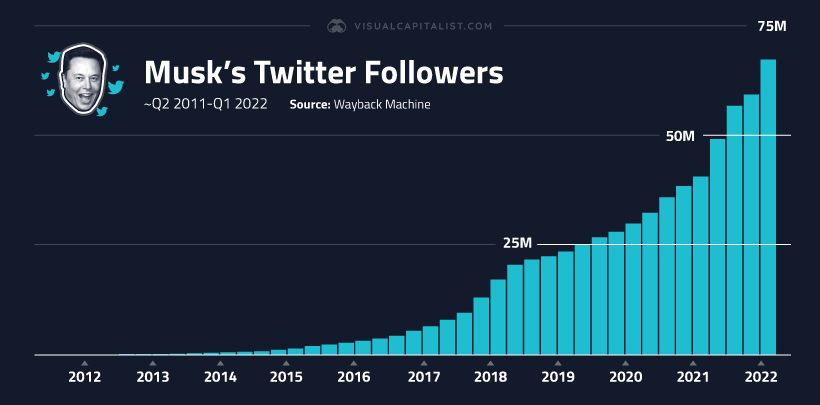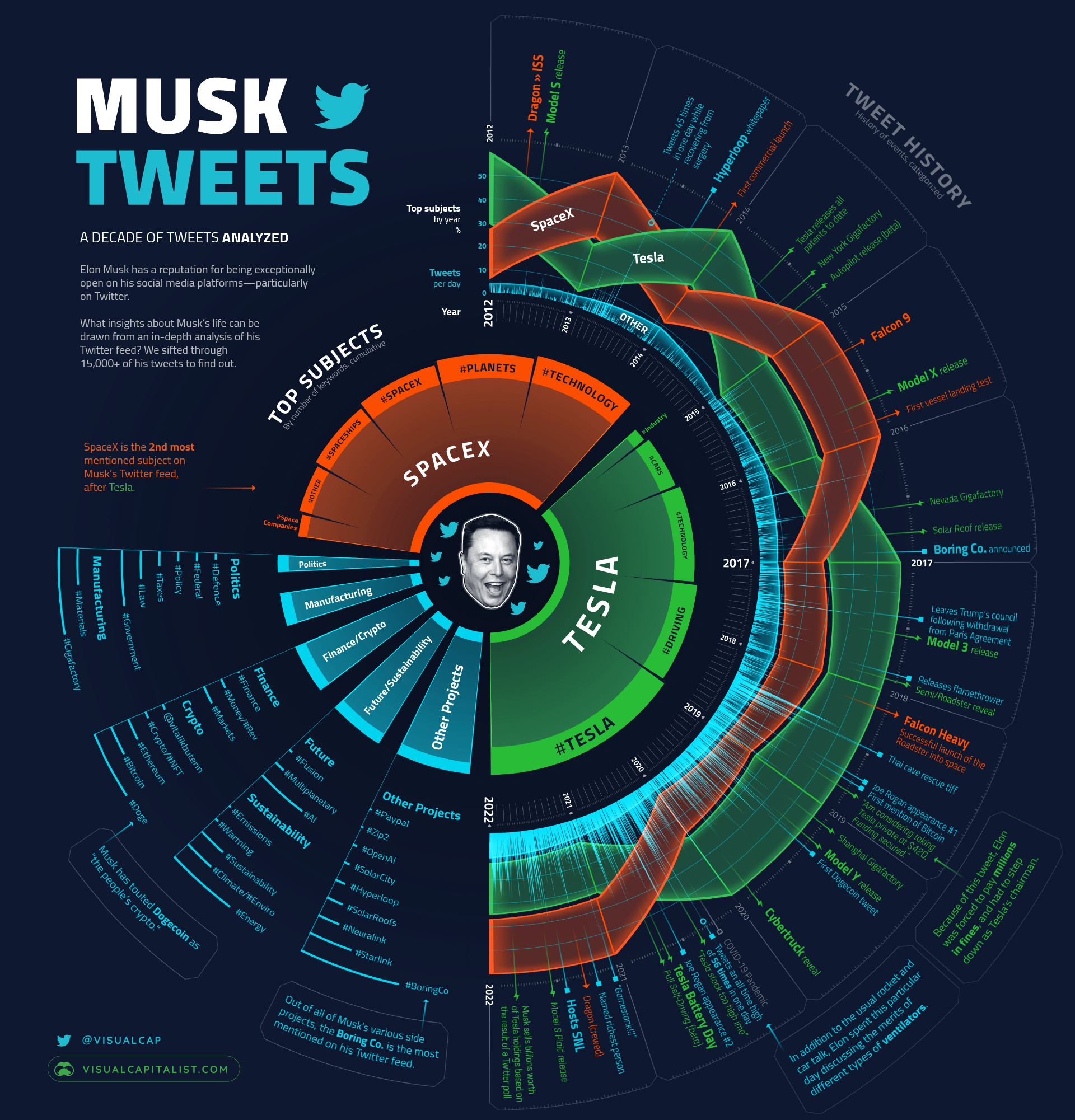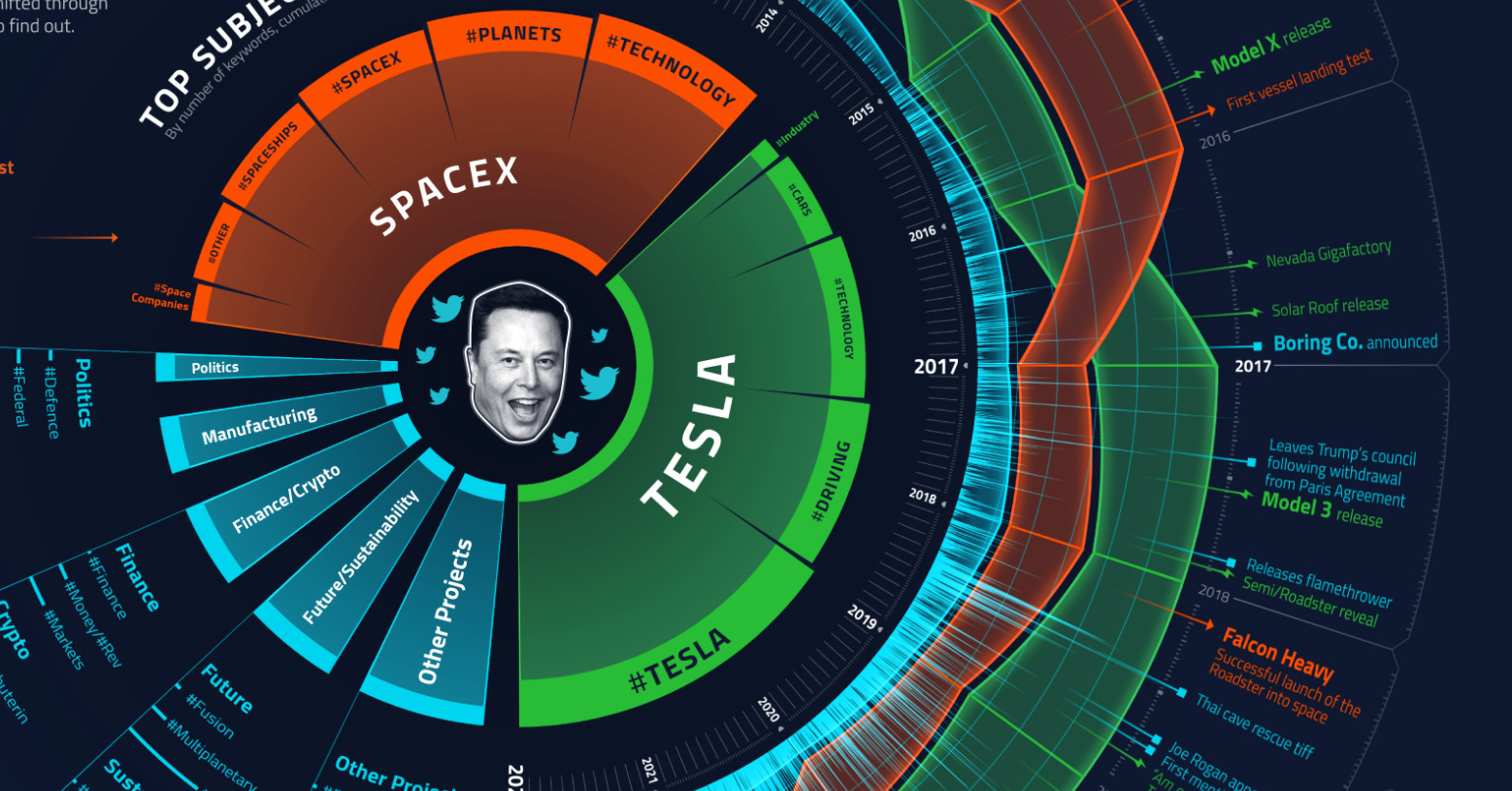Misc
A Decade of Elon Musk’s Tweets, Visualized
View the full-size version of this graphic.
An Analysis of Elon Musk’s Entire Twitter Feed
Elon Musk is known for many things, but one of his most buzzworthy claims to fame is his online Twitter presence.
Because of its candid nature, Musk’s Twitter feed provides the public with a unique opportunity to catch an unfiltered look into his eccentric mind.
What can we learn from an in-depth look at Elon Musk’s Twitter feed? What subjects does he focus on the most, and how has his Twitter use changed over the past decade?
We sifted through his entire tweet history to find out.
Why Bother?
To gain a high-level understanding of Musk’s Twitter profile, our research team sifted through his entire Twitter feed and compiled 15,000 of his tweets into a comprehensive dataset.
Why go to all the effort? Here are a few reasons why we spent months sifting through Elon Musk’s Twitter feed:
- People care about what he has to say: Musk has over 77 million followers on Twitter, and his account is currently the 11th most followed (coming in between Ellen DeGeneres and Narendra Modi, the Prime Minister of India). Even run-of-the-mill replies to regular Twitter users receive thousands of shares, likes, and comments. Clearly, people are interested in his ideas and interactions.
- Musk tweets often, and candidly: These days, it’s not uncommon for Musk to share more than 30 tweets in a single day. And his Twitter conversations cover a wide range of topics, from serious conversations about technical aspects of his products to lighthearted memes. This is highly unusual for a person in his position.
- Some of his tweets have had a big impact: Elon’s tweets consistently make headlines and ruffle the feathers of big shots in business and politics. Elon’s Twitter fingers have moved the needle on everything from Tesla’s stock price to cryptocurrency markets.
- He’s become a public icon: He’s currently the richest person in the world, and last year, he was named Time Magazine’s Person of the Year. The companies that Musk runs are also hugely influential and disruptive. In other words, no matter how you feel about him personally, he’s a pretty big deal.
Because of the above, we thought digging into the depths of Elon Musk’s Twitter feed was a worthy pursuit. Below, we’ll get into our methodology, and how we went about analyzing the mountains of tweets.
How We Did It: Notes on Our Methodology
Once we scraped a decade worth of Elon Musk tweets, we dug through the data and sorted the information to answer two main questions:
- What are Elon Musk’s most tweeted topics?
- How has his Twitter activity changed over the years?
To answer the first question, we sorted Elon’s tweets into categories (based on keywords) and ranked each category based on the volume of mentions.
The results are visualized in the circle chart in the middle of the graphic, which shows Musk’s most tweeted subjects over the last decade.
To answer our second question (how has Elon’s Twitter activity changed over the years) we sorted Elon’s feed into three main topics—Tesla, SpaceX, and everything else—and showed which topics dominated his feed each year.
Main Takeaways from the Analysis
Perhaps unsurprisingly, we found that the two main things Elon talks about the most are Tesla and SpaceX. He’s mentioned both companies consistently over the last decade, and as the timeline shows, Tesla and SpaceX take turns in the spotlight, depending on what’s going on for the companies at the time.
While the topics and themes of his content have remained fairly consistent, the frequency of tweets has grown over the years.
| Year | Number of tweets | Busiest month on Twitter |
|---|---|---|
| 2011 | 42 | December (42) |
| 2012 | 270 | May (36) |
| 2013 | 422 | May (118) |
| 2014 | 189 | April (36) |
| 2015 | 617 | October (132) |
| 2016 | 736 | July (126) |
| 2017 | 1,162 | December (197) |
| 2018 | 2,288 | May (384) |
| 2019 | 2,933 | April (373) |
| 2020 | 3,367 | July (446) |
| 2021 | 3,113 | July (402) |
Musk now uses Twitter very consistently, tweeting at least once on all but 14 days in 2021. His follower count has growth steadily over the years too:

As the above graphic shows, his follower growth started to escalate between late 2017 and mid-2018 as Musk began to burst into the public consciousness. Why? A lot was happening both personally and professionally for the busy founder:
-
- December 2017: Announcement on Twitter that the Boring Company was planning to release a limited edition flamethrower. 20,000 units were sold before the product was discontinued.
- February 2018: Tesla Roadster was launched into space.
- July 2018: 12 boys and their teacher get trapped in a cave in Thailand, and Elon gets heavily involved in efforts to try and rescue them. This includes an awkward—now deleted—tweet referring to a British cave diver as a pedophile. (Musk later won a defamation case in 2019.)
- August 2018: Elon announces on Twitter that he’s considering taking Tesla private at $420 a share. Tesla’s share price promptly dropped after this now infamous tweet was sent.
- Sept 2018: Musk appears on Joe Rogan’s podcast, and smokes weed with him. The spectacle grabs headlines after the podcast is published.
- From 2016 to 2018: A highly publicized, on-again-off-again relationship with actress Amber Heard.
No matter how outlandish or shocking his comments have been, Musk’s companies continue to see success, and people have continued to show interest in keeping up with the founder’s thoughts—and dank memes—on Twitter.
Highlights (and Lowlights) of Musk’s Twitter History
In the next section below, we’ll cover some of Elon’s most iconic Twitter moments, hand-selected by our research team.
The End of the Fake Elon Era
Elon Musk’s first real tweet was shared in 2010. Prior to that, someone was pretending to be him and using the Twitter handle @elonmusk to tweet random and controversial things.
Luckily, the imposter didn’t gain much traction, and the real Elon Musk cleared the air on June 4, 2010, with a tweet announcing his authentic arrival onto the platform:
Please ignore prior tweets, as that was someone pretending to be me :) This is actually me.
— Elon Musk (@elonmusk) June 4, 2010
After this initial tweet, Musk didn’t tweet again until the end of 2011, though his account was still verified that year. His Twitter activity remained relatively low until 2012.
A Splashdown to Remember
In May 2012, Musk went to Twitter to share his excitement after the Dragon spacecraft successfully returned home.
Splashdown successful!! Sending fast boat to Dragon lat/long provided by P3 tracking planes #Dragon
— Elon Musk (@elonmusk) May 31, 2012
This landing made history, as SpaceX became the first commercial spacecraft to deliver cargo to the International Space Station.
The engagement on this tweet highlights how much larger Musk’s audience is today. The tweet above, which is highlighting some very exciting news, only has about 350 retweets.
The Boring Company Flamethrower
In late 2017, Musk started selling Boring Company merchandise, mostly as a joke. But products were selling, and Elon decided to take things one step further, and announced to Twitter that he’d release a Boring Company flamethrower if 50,000 Boring branded hats sold:
After 50k hats, we will start selling The Boring Company flamethrower
— Elon Musk (@elonmusk) December 11, 2017
The hats did sell out, so true to his word, Musk released a limited edition flamethrower at $500 bucks apiece. All 20,000 units sold out.
The $20 Million Quip
In August 2018, Musk told Twitter that he was considering taking Tesla private, at $420 a share.
Am considering taking Tesla private at $420. Funding secured.
— Elon Musk (@elonmusk) August 7, 2018
This tweet was a cheeky reference to marijuana, but it ended up costing a fortune. The SEC sued him with fraudulent charges, claiming this irresponsible tweet misled investors.
He ended up paying millions in fines, and had to step down as Tesla’s chairman as a result of the drama.
Candid COVID Opinions
Musk hasn’t been shy about sharing his thoughts on the global pandemic. On March 6, 2020, he tweeted “the coronavirus panic is dumb.” Since then, he’s been vocal about his distrust in antigen tests, and isn’t afraid to share his frustrations around lockdowns with his followers:
FREE AMERICA NOW
— Elon Musk (@elonmusk) April 29, 2020
He’s also said that the virus isn’t that deadly and that COVID-19 related deaths were inflated because doctors were wrongfully attributing deaths to the virus instead of other causes.
Becoming the World’s Richest Human
In 2021, Musk surpassed Jeff Bezos to become the richest person in the world. His reaction was quite understated. In response to a tweet from @teslaownersSV sharing the news, he simply said, “how strange.”
From there, he tweeted:
Back to work I go …
— Elon Musk (@elonmusk) February 8, 2021
Musk is still currently the richest person on the planet as of this article’s publication date, with a net worth of $213 billion.
Bitcoin Boost
Elon Musk’s foray into Bitcoin boosterism ramped up on January 29, 2021, when he added “#bitcoin” to his Twitter profile page, a move that appeared to have an impact on the price of BTC.
Days later, Musk announced that Tesla acquired $1.5 billion in bitcoin, with plans to accept it as payment.
You can now buy a Tesla with Bitcoin
— Elon Musk (@elonmusk) March 24, 2021
The news caused the price of Bitcoin to jump 17% to $44,000, a record high at the time. Bitcoin remained in the spotlight through the year as the cryptocurrency continued to gather support from major financial institutions.
Just days prior, Musk also added fuel to the speculative fire surrounding the GameStop stock. By simply tweeting the word “Gamestonk” paired with a link to Reddit’s infamous r/wallstreetbets, GME’s price exploded more than 150% higher.
The Multi-Billion Dollar Question
After facing backlash over his significant stockpile of wealth, Musk turned to Twitter to ask users if he should sell 10% of his Tesla stock in order to pay taxes.
Much is made lately of unrealized gains being a means of tax avoidance, so I propose selling 10% of my Tesla stock.
Do you support this?
— Elon Musk (@elonmusk) November 6, 2021
The majority of Twitter users voted yes, and the billionaire actually followed through and sold more than $16 billion worth of Tesla stock.
Reconnecting Ukraine
In late February, as Russia launched its offensive in Ukraine, Mykhailo Fedorov, Ukraine’s Vice Prime Minister and Minister of Digital Transformation called the SpaceX founder out on Twitter, asking for support.
Starlink service is now active in Ukraine. More terminals en route.
— Elon Musk (@elonmusk) February 26, 2022
Musk would reply within 24 hours, and soon after, Fedorov would tweet a photo of Starlink terminals arriving safely in the country.
VC+
VC+: Get Our Key Takeaways From the IMF’s World Economic Outlook
A sneak preview of the exclusive VC+ Special Dispatch—your shortcut to understanding IMF’s World Economic Outlook report.

Have you read IMF’s latest World Economic Outlook yet? At a daunting 202 pages, we don’t blame you if it’s still on your to-do list.
But don’t worry, you don’t need to read the whole April release, because we’ve already done the hard work for you.
To save you time and effort, the Visual Capitalist team has compiled a visual analysis of everything you need to know from the report—and our VC+ Special Dispatch is available exclusively to VC+ members. All you need to do is log into the VC+ Archive.
If you’re not already subscribed to VC+, make sure you sign up now to access the full analysis of the IMF report, and more (we release similar deep dives every week).
For now, here’s what VC+ members get to see.
Your Shortcut to Understanding IMF’s World Economic Outlook
With long and short-term growth prospects declining for many countries around the world, this Special Dispatch offers a visual analysis of the key figures and takeaways from the IMF’s report including:
- The global decline in economic growth forecasts
- Real GDP growth and inflation forecasts for major nations in 2024
- When interest rate cuts will happen and interest rate forecasts
- How debt-to-GDP ratios have changed since 2000
- And much more!
Get the Full Breakdown in the Next VC+ Special Dispatch
VC+ members can access the full Special Dispatch by logging into the VC+ Archive, where you can also check out previous releases.
Make sure you join VC+ now to see exclusive charts and the full analysis of key takeaways from IMF’s World Economic Outlook.
Don’t miss out. Become a VC+ member today.
What You Get When You Become a VC+ Member
VC+ is Visual Capitalist’s premium subscription. As a member, you’ll get the following:
- Special Dispatches: Deep dive visual briefings on crucial reports and global trends
- Markets This Month: A snappy summary of the state of the markets and what to look out for
- The Trendline: Weekly curation of the best visualizations from across the globe
- Global Forecast Series: Our flagship annual report that covers everything you need to know related to the economy, markets, geopolitics, and the latest tech trends
- VC+ Archive: Hundreds of previously released VC+ briefings and reports that you’ve been missing out on, all in one dedicated hub
You can get all of the above, and more, by joining VC+ today.
-

 Mining1 week ago
Mining1 week agoGold vs. S&P 500: Which Has Grown More Over Five Years?
-

 Markets2 weeks ago
Markets2 weeks agoRanked: The Most Valuable Housing Markets in America
-

 Money2 weeks ago
Money2 weeks agoWhich States Have the Highest Minimum Wage in America?
-

 AI2 weeks ago
AI2 weeks agoRanked: Semiconductor Companies by Industry Revenue Share
-

 Markets2 weeks ago
Markets2 weeks agoRanked: The World’s Top Flight Routes, by Revenue
-

 Countries2 weeks ago
Countries2 weeks agoPopulation Projections: The World’s 6 Largest Countries in 2075
-

 Markets2 weeks ago
Markets2 weeks agoThe Top 10 States by Real GDP Growth in 2023
-

 Demographics2 weeks ago
Demographics2 weeks agoThe Smallest Gender Wage Gaps in OECD Countries


















